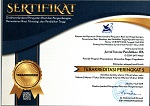KERUKUNAN ANTARUMAT BERAGAMA SEBAGAI DASAR CITY BRANDING HARMONI KEDIRI THE SERVICE CITY
Abstract
This article described inter-religious harmony as social identities of Kediri and the imple- mentation of Harmoni Kediri city branding as The Service City. This article used a qualitative de- scriptive approach with the form of case studies. Data collection used interview, observation and documentation techniques. The results of this study showed that inter-religious harmony was well established, due to the communication of religious leaders and community leaders who were mem- bers of the FKUB to create safe, peaceful and peaceful situations and conditions. To realize Harmoni Kediri’s city branding as The Service City through 3 (three) programs, namely: Prodamas; Coffee Tofu; and Heaven.
Keywords
Full Text:
PDFReferences
Fidiyani, R. 2013. Kerukunan umat beragama di indonesia (belajar keharmonisan dan toleransi umat beragama di desa cikakak, kec. Wangon, kab. Banyumas). Jurnal Dinamika Hukum, Vol. 13 No. 3, 468-482.
Hasan, N. 2014. Kerukunan Intern Umat Beragama Di Kota Gerbang Salam (Melacak Peran Forum Komunikasi Ormas Islam [Fokus] Pamekasan). Nuansa, Vol 11, No. 2. 263-292.
Irina, A. 2012. Branding cities as educational cen- tres. The role of higher education institu- tions. Management & marketing, vol 7, No 3, hal 493-512.
Kasali, R. 2015. City Branding, (Online), (http:// www2.jawapos.com/baca/opinidetail/ 14258/City-Branding-, diakses 13 Juli 2018).
Kavaratzis, M. 2009. Cities and Their brands: Lessons from corporate branding.Place Branding and Public Diplomacy, 5 (1),26-37.
Kowalik, I. 2012. Influence of trade fairs on a host city brand. Public Policy and Admin- istration. Vol 11, No. 4. Hal 629-640.
Miles, M. B & Huberman, A. M. 1994. Qualita- tive data analysis: an expended sourcebook (2nd ed). London: SAGE
Pamungkas, A.S., & Octaviani, G. 2017. Aksi bela islam dan ruang publik muslim: dari representasi daring ke komunitas luring. Jurnal Pemikiran Sosiologi, 67.
Pedersen, L. 2016. Religious pluralism in Indone- sia. The Asia Pasific of Anthropology, 387-398.
Rosyid, M. 2013. Harmoni kehidupan sosial beda agama dan aliran di kudus. Addin, 42-64.
Simoes, C. and Dibb, S. 2001. Rethinking the brand concept: New brand orientation. Corporate Communications: An International Jour- nal 6(4): 217–224.
Suhartini. 2015. City Branding Kabupaten Tuban Sebagai Bumi Wali. Program Studi Ilmu Komunikasi Fakultas dakwah dan Komunikasi. Surabaya: UIN Sunan Ampel Surabaya.
Suryawan, N. W., & Danial, E. 2016. Implementasi semangat persatuan pada masyarakat multikultural melalui agenda forum kerukunan umat beragama (fkub) kabupaten malang. Humanika, Vol 23, No. 1, 46-60.
Tangkilisan, H. N. S. 2005. Manajemen publik. Jakarta: Grassindo.
Refbacks
- There are currently no refbacks.
Copyright (c) 2018 Jurnal Ilmiah Pendidikan Pancasila dan Kewarganegaraan

This work is licensed under a Creative Commons Attribution 4.0 International License.
View My Stats











